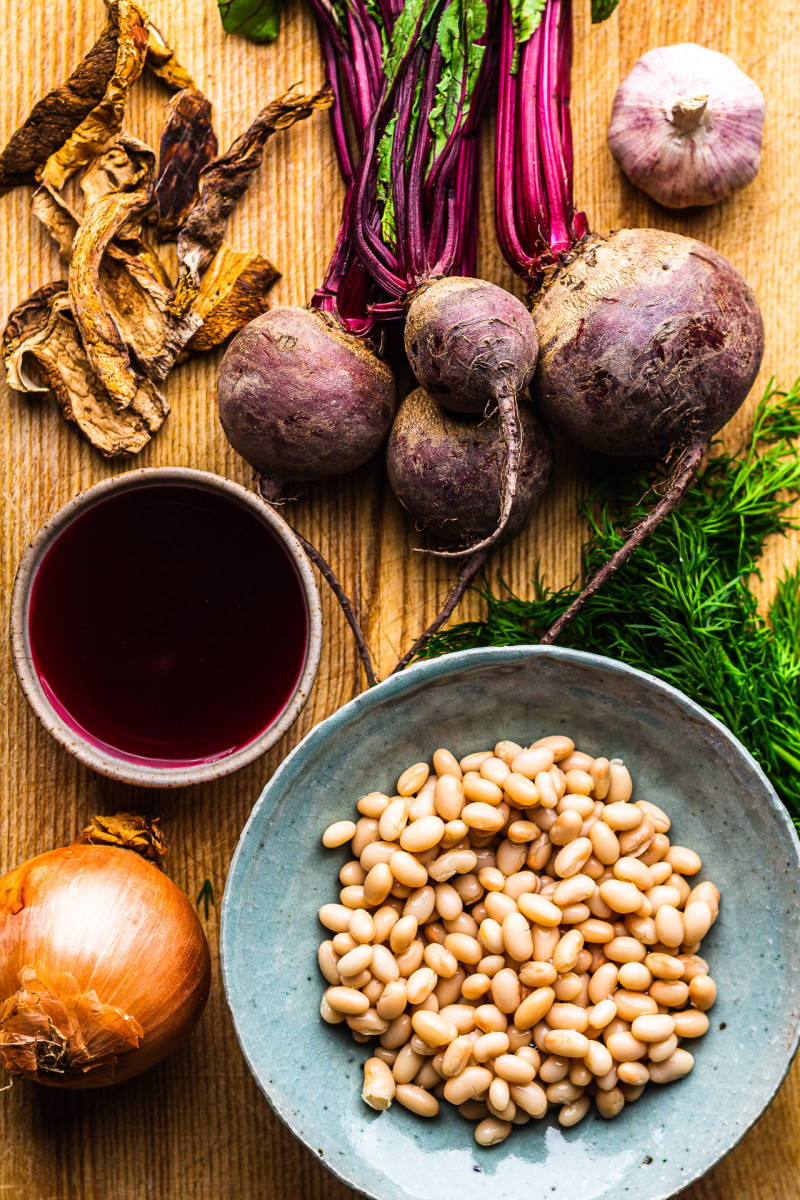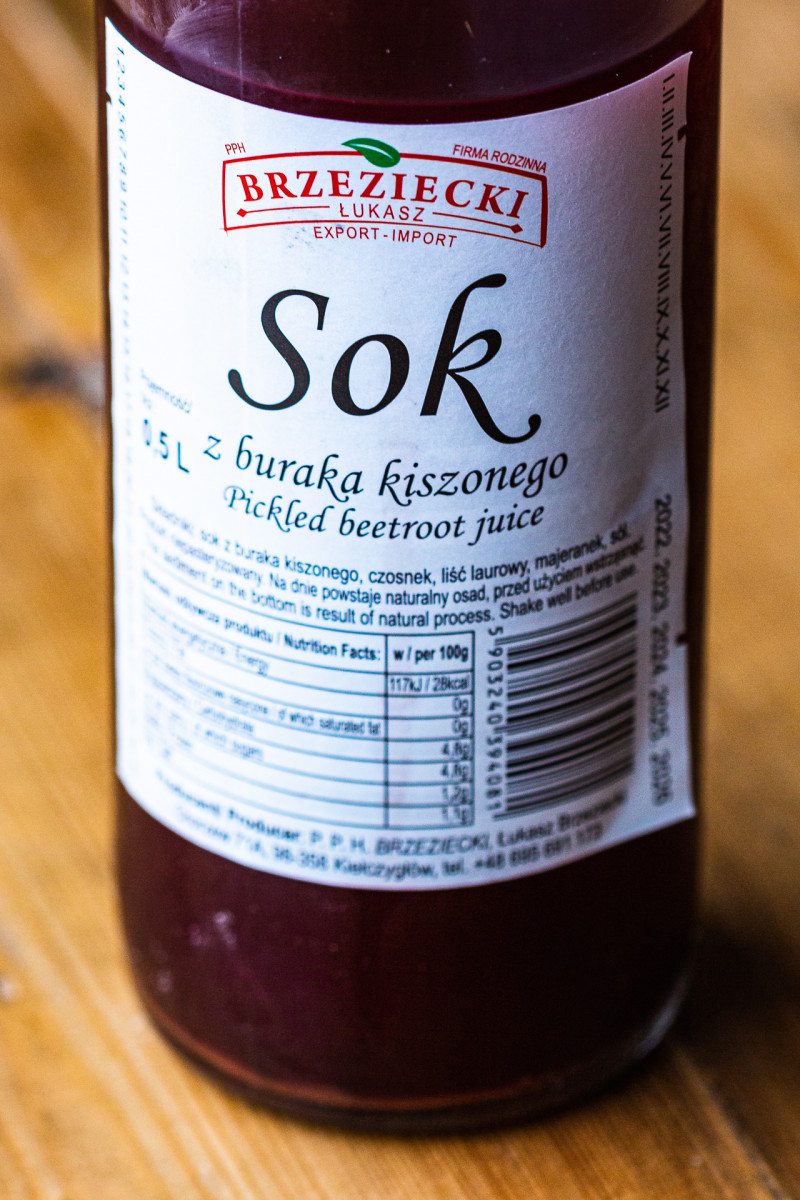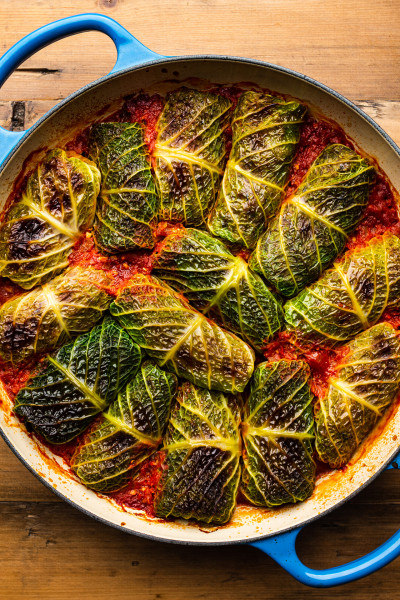
Today’s recipe is one of my childhood staples – borscht (to the English speaking world) or barszcz, as I know it. The timing is perfect as this lovely interview I did with Erin (of Olives For Dinner) has made me think of my food inspiration and, like with a lot of things, I landed on my childhood.
Put simply, barszcz is a Polish name for a beetroot soup that is a shared staple in the whole of the Eastern Europe and the word borscht is an anglicised version of the Yiddish word for it.
There are many many versions of this bright pink soup as it’s eaten throughout the year. Spring and summer versions see Poles making a lighter cousin of borscht, which we call botwinka, It’s light and bright, made with entire young beetroots including leaves and stems.
Autumn and winter versions are heavier – unfortunately often made with beef stock apart from the Christmas version, which is traditionally vegetarian. That last one uses a generous amount of mushroom stock and is served with little porcini filled ravioli-like dumplings (we call them uszka meaning tiny ears). I will publish a recipe for this dish separately at some point..
As with many similar dishes, there is often debate about the origins of borscht as so many neighbouring countries share the tradition of making it. It is thought that borscht originated in what is now Ukraine but the dish spread far and wide and every culture (in fact every household) makes it a little differently. My paternal grandma was from the beautiful city of Lviv (which was then Polish but is now part of Ukraine) and she made borscht differently to how my maternal grandma, who was from Krakow, made it.
This version is inspired by my maternal grandma as she used to serve hers with tiny white beans – haricot beans – and I used to love it as a child.
Because I am a massive mushroom fan and have a huge jar of dried porcini mushrooms sitting on my kitchen counter that I really need to use up, I add a generous amount of porcini stock to my borscht to add richness and flavour in the absence of meat stock, but that’s optional. You could cheat by using a mushroom stock cube or, don’t tell anyone Polish I do this, go off in a completely unorthodox direction and add a splash of mushroom soy sauce instead.
Some cooks slice beetroot thinly and then leave it at the bottom of the pot – they serve a clear borscht – and keep the beetroot to make other dishes with. This is especially common if borscht is served in a mug, as a hot and comforting beverage with a side of savoury pastry (usually puff pastry filled with a sour cabbage and mushroom filling – a bit like these rolls but bigger). I like to eat my beetroot with the soup, it adds texture and sustenance, and to make it easier to eat, I tend to cut it into small uniform cubes, but you could shred it in a food processor to save yourself work.
MORE ABOUT THE INGREDIENTS

BEETS: As borscht is very much a beetroot soup, fresh beetroot and lots of it is a non negotiable. You can cut it into thin slices and serve borscht as a clear soup, but I prefer to cube my beets and include a generous amount of beet cubes in each serving. If cubing a kilogram of beetroot is too much work, another method is to shred it in a food processor like you would for a salad.

GARLIC: This is very personal so feel free to adapt to your tastebuds. For me a good borscht tastes quite strongly of garlic so I sauté quite a few cloves in the actual soup and I season the soup with an extra raw garlic clove at the very end. If that sounds like too much, skip the raw clove and maybe go down to two garlic cloves in the soup.
VEGGIE STOCK: Use ready made (homemade or shop-bought) veggie stock to add volume to the soup or add a large chopped carrot and a few stalks of celery to the pot after you caramelised onion and garlic. An apple, a chunk of cabbage (white or Savoy) or a parsnip is can also be used – the more (variety) the merrier.
HERBS: I like to use a small amount – a few pinches really – of dried marjoram and thyme, but you can skip them if you like. I also like to dust the soup with fresh dill, which is not always traditional. In Poland, summer variety (botwinka) is most often served with fresh dill, but I think it totally belongs.
SPICES: Typically a few dry spices are used, most commonly all spice berries and bay leaves but some people also include whole peppercorns (about ½-1 tsp, depending on how peppery you like it).
SOUR BEET JUICE: This ingredient is quite key when it comes to a good beet soup, it adds a lot of flavour and it’s super healthy for you too. You can make it yourself at home by fermenting salted beets (a process akin to making kimchi or sauerkraut) or you can buy it. Here in the UK, most large supermarkets with a Polish (or Eastern European) food section sell it or try a Polish shop on the high street. You want to get a proper sour beet juice though, which means one where beets are fermented naturally rather than one with added vinegar. If you can’t find it, don’t worry. You could use a bit of saurkraut brine (kimchi brine would be lovely too if you love spice) or sour gherkin brine as a last resort but be careful with this one as its distinctive flavour can overpower the star of the show. If none of the above are an option, you can add acidity using lemon juice or apple cider vinegar instead.

PORCINI STOCK: So typically only the Christmas version of borscht would include porcini stock, but as this is a vegan soup and so it’s not made using beef stock, I like to add some porcini stock in its place to deepen the flavours nicely. If you don’t have porcini, simply use a mushroom stock cube or, if you are not afraid to be untraditional like me, a splash of mushroom soy sauce (in place of some salt) will also do a great job – just don’t tell any Polish people you know that I said that 😉 .
LEMON or VINEGAR: A dash of lemon juice or vinegar (my mum uses apple cider vinegar) is often used alongside sour beet juice for extra acidity. If your sour beet juice is sour enough, there may be no need to add any more acidic ingredients but sometimes it’s too mild and a squeeze of lemon really helps.
SUGAR/SWEETENER: Beets are naturally sweet so you don’t need much added sweetness, but a small amount of it works beautifully. I like to add a touch of date syrup – I buy a jar of it in my local corner store but you can also make it, it lasts for ages in the fridge but sugar is absolutely fine too.
HARICOT BEANS: So as this version of borscht is based on that my grandma used to make, I included haricot beans in my recipe. They are delicious, nutritious and make this simple soup into more of a meal. I used canned haricot beans as they are widely available. Of beans do not appeal, how about serving it with some cooked potatoes? That’s also very common.




- 20 g / 0.7 oz dried porcini* (optional)
- 1 kg / 35 oz beetroots
- 2 tbsp / 30 ml olive oil
- 1 large onion, finely diced
- 5 garlic cloves, 4 finely sliced + 1 whole
- ½ tsp dried marjoram and thyme
- 3 all spice berries
- 2 bay leaves
- salt and pepper to taste
- 1 litre / 4 cups veggie stock*
- sugar or neutral sweetener, to taste
- 2 x 400 g / 14 oz cans haricot beans
- approx. 120 ml / ½ cup fermented/sour beet juice (or sauerkraut brine), to taste*
- fresh dill, to serve (optional)
- vegan cream*, to serve (optional)
- Start by making porcini stock (if using). Cover cleaned porcini in 500 ml / 2 cups of boiling water. Set aside for as long as you can.
- Next, peel and dice your beets into small dice – you can also grate them in a food processor or slice thinly.
- Heat up olive in a large, heavy bottomed pot. Add diced onion and sauté for a few minutes until translucent and softened.
- Add four garlic cloves, dried herbs, bay leaves, all spice berries, a good pinch of salt and pepper to the pot. Sauté until garlic has softened
- Add cubed beets, veggie and (if using) mushroom stock – make sure not to disturb the grit that tends to settle on the bottom. Keep rehydrated porcini for pierogi or lasagne.
- Simmer the soup on low heat for about 45 minutes, until beetroot cubes have softened and all the veggies released their goodness. Add drained beans and let them warm up briefly.
- Season with more salt and pepper, freshly grated clove of garlic, sour beet juice (or sauerkraut brine) and/or lemon/apple cider vinegar if you feel that it needs even more acidity. A small amount of sugar (I use date syrup) is often needed too.
- Cool down and refrigerate for a day for deeper flavour or rest for at least 1 hour if consumed straight away. Serve with a dollop of vegan cream, fresh dill and a homemade bread.
*DRIED PORCINI: they add richness and depth of flavour and are always added to the Christmas version of barszcz (Polish for borscht, the word borscht is an anglicisation of the Yiddish words for this soup). If you don’t have them, your can skip them or use a mushroom stock cube or (my cheat, NOT TRADITIONAL) use some mushroom soy sauce (in place of some of the salt).
*VEGAN CREAM: you can use shop-bought or make your own. I make mine by blitzing 65 g / ½ cup of soaked (and drained) raw cashews with 60 ml / ¼ cup of water, some lemon juice and a good pinch of salt until silky smooth.









I am sorry to hear that, I hope they will show up soon. Ania
I am not sure what sour salt (I've never come across it) so I cannot advise but yes, you might be right. Ania